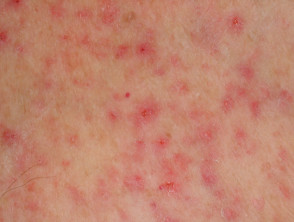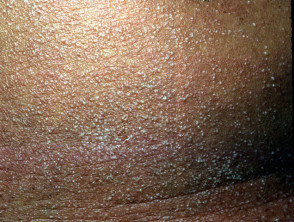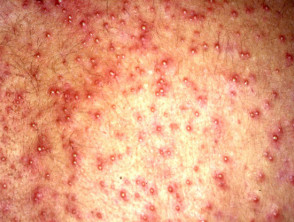What is miliaria?
Miliaria is a common skin disease caused by blockage and/or inflammation of eccrine sweat ducts. Miliaria is frequently seen in hot, humid, or tropical climates, in patients in hospital, and in the neonatal period. Miliaria is also known as heat rash, sweat rash or prickly heat.
Based on the level of the sweat duct obstruction, miliaria is divided into three types:
- Miliaria crystallina (sudamina) is due to obstruction of the sweat ducts close to the surface of the skin in the stratum corneum of the epidermis
- Miliaria rubra follows obstruction of the sweat ducts in the deeper layers of the skin (mid-epidermis)
- Miliaria profunda (tropical anhidrosis) is the result of sweat leaking from the sweat glands into the middle layer of skin (blockage at or below the dermoepidermal junction) following repeated episodes of miliaria rubra.
Miliaria
Who gets miliaria?
- Miliaria crystallina affects up to 9% of neonates, with the mean age of 1 week. It can also occur in adults with fever.
- Miliaria rubra is the most common type of heat rash. It is seen in children and in up to 30% of adults who move to a tropical environment or are unexpectedly exposed to heat and humidity. Although miliaria may develop within days of arriving in the tropics, it often takes several months to peak.
- Miliaria profunda is rare and presents in adult males.
Heat rash can affect all age groups and racial groups.
What causes miliaria?
Prickly heat results from sweating. The main contributing causes and risk factors are:
- Immature sweat ducts in a newborn child
- A hot and humid environment
- Intense exercise or physical activity
- Fever
- Occlusion of the skin with non-porous dressings or synthetic clothing against the skin
- Hospitalised or bedridden patients lying on waterproofed mattresses or mattress-protectors.
Other diseases and treatments that have been associated with miliaria are:
- Drug-induced hyperhidrosis
- Adverse reaction to medication such as induction chemotherapy
- Stevens-Johnson syndrome / toxic epidermal necrolysis
- Genetic disease (Morvan syndrome and pseudohypoaldosteronism type I)
- Radiotherapy.
What are the clinical features of miliaria?
Symptoms of heat rash vary depending on type:
- Miliaria crystallina presents as 1–2 mm superficial clear blisters that easily break. The blisters can look like beads of sweat. There is no inflammation. The blisters are usually seen widely spread on the head, neck, and upper trunk. The vesicles break easily to leave a bran-like scale.
- Miliaria rubra, the most common form of heat rash, results in red, 2–4 mm, non-follicular papules and papulovesicles. They are very itchy. Background erythema is often present. In children, miliaria involves the trunk and the skin folds of the neck, axilla or groin. In adults, miliaria often affects the upper trunk, scalp, neck and flexures, particularly in areas of friction with clothing.
- Miliaria pustulosa is a variant of miliaria rubra with pustules.
- Miliaria profunda presents as asymptomatic deep papules. The flesh–coloured, 1–3 mm diameter papules develop on the trunk and extremities.
What are the complications of miliaria?
Complications of miliaria include:
- Secondary bacterial infection, commonly caused by staphylococci
- Impaired thermoregulation
- Hyperhidrosis in non-affected areas.
How is miliaria diagnosed?
Heat rash is diagnosed on its typical clinical presentation.
In severe cases or repeated episodes, punch biopsy can be useful. Miliaria crystallina shows vesicles associated with the sweat ducts within or just under the stratum corneum of the epidermis. Histology of miliaria rubra shows spongiosis and spongiotic vesicles.
Tzanck smear taken from vesicles will distinguish miliaria from herpes simplex or toxic erythema of the newborn.
What is the differential diagnosis for miliaria?
Skin disorders presenting with papules, vesicles, or pustules that look similar to miliaria include:
- Herpes simplex
- Fungal infections
- Bacterial folliculitis
- Acne
- Acute generalised exanthematous pustulosis (AGEP)
- Toxic erythema of newborn
- Grover disease.
What is the treatment for miliaria?
Resolution of miliaria requires minimising heat and humidity to reduce sweating and the avoidance of irritation to the skin. Strategies to avoid sweating, keeping the skin cool, and reducing irritation can help treat and prevent heat rash:
- Work in an air-conditioned office for at least a few hours a day
- Sleep in a ventilated, cool bedroom
- Move away from a tropical climate, avoiding humid weather
- Avoid excessive clothing and tight clothing
- Avoid excessive soap and irritants
- Wear shirts and blouses made of breathable synthetic fabrics or cotton
- Remove wet clothing
- Cool water compresses and taking a cool bath
- Patients should be education on symptoms of heat exhausation.
Heat rash may require medical care which can involve:
- Calamine lotion to relieve discomfort; because calamine lotion is drying, an emollient may be required.
- Treatment of fever with antipyretic such as paracetamol (American terminology acetoaminophen)
- Mild topical steroids
- Antiseptics and anti-staphylococcal antibiotics for secondary infection.
What is the outcome for miliaria?
Most cases of heat rash resolve within a day or two after changing to a cooler environment without any treatment or complications.


